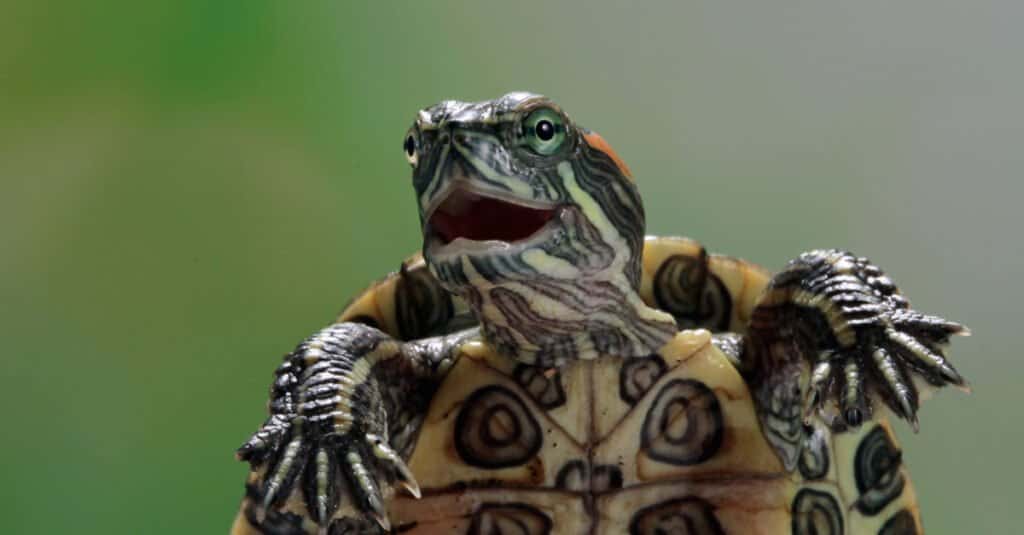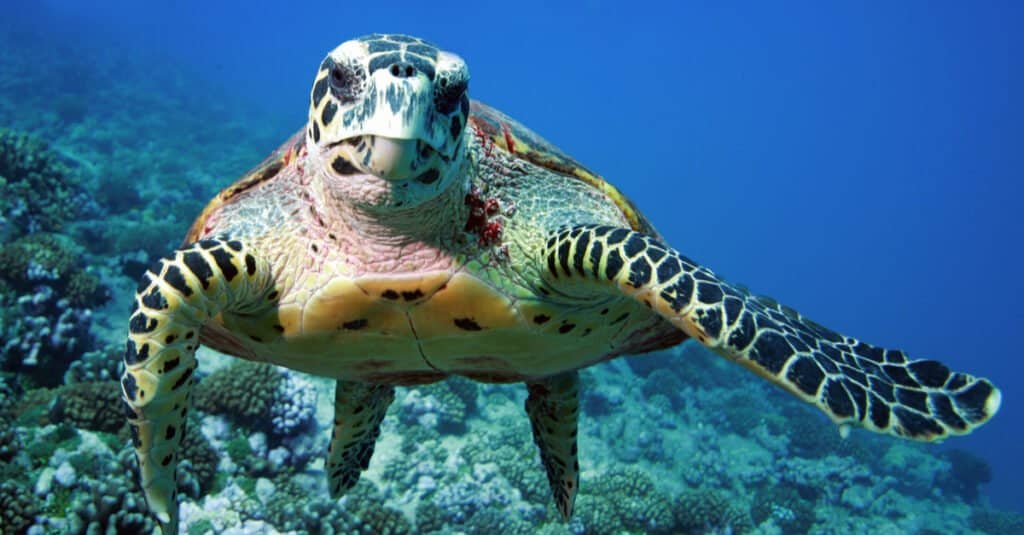Turtles are not mammals, they are reptiles. Mammals are animals that usually have hair or fur. Cetaceans have lost their fur to make them more streamlined as they swim, but once in a while, a whale is found with a whisker or two. Mammals have vertebrae and are warm-blooded, though there are mammals, such as the rock hyrax and the sloth that aren’t as warm-blooded as a mammal usually is. Mammals breathe air. This includes cetaceans such as dolphins and whales and sirenians such as manatees, who live their entire lives in water. Most of all, mammals nurse their babies with milk.
The majority of mammals give birth to live young, though the platypus and the echidna lay eggs. Most mammals are also placental. The placenta is a structure that delivers nutrients to the developing baby in the uterus. However, other mammals are marsupials, whose babies are born in a basically embryonic state and continue the rest of their development in their mother’s pouch. Mammals as a class of animals are also younger than reptiles and diverged from them around 300 million years ago.

©Kurit afshen/Shutterstock.com
Why Would People Think Turtles are Mammals?
People may think turtles are mammals because they breathe air and have vertebrae. One might even think that turtles are mammals because their meat is used in soups and stews as the meat of mammals such as cows and pigs are used in soups and stews.
So, now that we know turtles are not mammals, what are they? The turtle is considered a diapsid reptile, which means it has two holes in the sides of its skull. This puts the turtle in the same group of reptiles as snakes, crocodiles, some lizards, and tuataras. Interestingly, birds are also in this group of animals.

©Achimdiver/Shutterstock.com
Reptiles, the class to which turtles belong, developed about 312 million years ago. They are generally cold-blooded, which means their body temperature is determined by their environment. They do not have hair or fur, and their exposed skin is covered with scales or scutes. Turtles stand out from other reptiles, indeed from other vertebrates, in that they have a shell that is part of their skeleton. It is covered with scutes, a type of scale that is covered with keratin.
Reptiles may give birth to live young but most lay eggs. The extent of parental care depends on the species. Turtles only lay eggs, and they only lay eggs on land. Besides covering up her eggs after she’s laid them in the woods or on a beach, a turtle provides no parental care at all. Turtles do not have mammary glands and do not produce milk for their young, which is the primary characteristic of mammals.
Though there are turtles that spend much of their lives in water such as the sea turtles, all turtles must breathe air. If you live near any body of water, you may find turtles wandering around in late spring. These are usually females looking for a spot with soft, sandy soil to lay their eggs.
The greatest threat to turtles is loss of habitat and getting hit by a car. Turtles often cross roads looking for appropriate nesting areas or seeking new habitat and traffic is a major threat to them. You are most likely to see turtles in the roads from late May to early July. If you do see one in the road and can stop safely, you can pick them up by the sides of their shells and move them to the side of the road. Take them to whichever side of the road they are facing. You just might save an entire turtle generation!
Up Next…
- Painted Turtle These lovely turtles have bright red highlights on the edges of their shells. They often live in ponds and enjoy sunning themselves on floating logs or rocks near the shoreline.
- Snapping Turtle If you want to get an idea about what a dinosaur might have looked like, check out snapping turtles. Although you should do it from a safe distance!
- Wood Turtle If you are lucky, you might find one of these near areas that have both woods and water nearby.
The photo featured at the top of this post is © Kurit afshen/Shutterstock.com
FAQs (Frequently Asked Questions)
Are turtles endangered?
Whether a turtle is endangered depends on its species. Mud turtles and painted turtles are mostly listed as of least concern even though they may be under pressure from habitat loss. Other turtles such as the northern red-bellied turtle are considered near threatened. Some species of sea turtles are endangered, with the hawksbill sea turtle listed as critically endangered. Sea turtles face more hazards than the more terrestrial turtles because they have to deal with being poached for their meat and their shells and being tangled in nets meant for other sea creatures. They’re also threatened by pollution and trash, including floating plastic bags that they mistake, sometimes fatally, for jellyfish, oil spills, and climate change. Even artificial lights can confuse sea turtle hatchlings and draw them away from the tide.
Are turtles dangerous?
Generally, turtles aren’t dangerous, but the alligator snapping turtle and the common snapping turtle are both a bit bad-tempered and can deliver a nasty bite. Yet even these turtles would rather retreat into the mud at the bottom of a body of water than have a confrontation.
How long can a turtle live?
Turtles are as famous for their longevity as they are for their shells. The oldest tortoise known, named Jonathan, was about 188 or 189 years old as of 2021. This makes him the oldest terrestrial animal. He is a Seychelles giant tortoise and lives on Saint Helena, an island in the south Atlantic Ocean. The much younger Lonesome George, a Pinta Island tortoise, passed away at the relatively youthful age of about 101 in 2012. Unfortunately, he may have been the last of his species.
Scientists believe turtles and tortoises live as long as they do because they grow very slowly and have a slow metabolism. This lets them survive even in conditions where food and water are scarce. It also helps to have a shell that deters predators and protects against the weather.
Do turtles make good pets?
Some turtles make good pets. Most aren’t expensive to buy, and once their habitat has been set up, they’re easy to care for. The one thing an owner needs to be mindful of is that a well-cared-for turtle can live a long time. Though the little red-eared slider might not live to be as old as Jonathan, it can live 30 or 40 years. Another thing to watch out for are unscrupulous sellers who may offer turtles that are endangered in the wild or that are illegal to buy or sell for whatever reason.
Because they’re not mammals, a turtle’s enclosure needs to be kept warm, and if it’s semi-aquatic, there should be a place where it can come out of the water and bask.
Other turtles are best left in the wild. Snapping turtles are irascible, and their necks are so long and flexible that they can deliver a bite even when they’re gripped from behind. Some tortoises have an instinct to dig and this instinct may make them destructive, especially if they are large. Of course, no turtle should be taken in from the wild and kept as a pet.
What’s the difference between a turtle, a tortoise, and a terrapin?
A turtle is a member of the Testudinidae family whose members usually live around or in water and are carnivores or omnivores. Tortoises live on land and are herbivores. Terrapins live in freshwater or brackish water. The name comes from the Algonquian word for the diamondback terrapin, a pretty terrapin that lives in the marshes of Bermuda and the east coast of the United States.
Why do turtles have shells?
The shell is probably one of the reasons that turtles and tortoises live as long as they do. Simply, it protects them from predators and bad weather. It’s made up of the carapace, which is on top, and the plastron, which is on the underside. Extensions on the plastron connect it to the carapace. Both the carapace and the plastron are made out of bone. Exceptions to this are softshell turtles and the leatherback turtle, which is a sea turtle. Some turtles, such as box turtles, can pull their head, legs, and tail into their shell, and shut it completely.
A person can sometimes tell the difference between a turtle and a tortoise by the shape of the shell. Tortoises tend to have domed shells while the shells of turtles are flatter. The shells of sea turtles are flat and smooth to make them more hydrodynamic.
Are turtles omnivores, herbivores or carnivores?
Turtles can be all of the above. Tortoises are herbivores while snapping turtles will eat just about anything they can handle, including mammals, other reptiles, birds that fall into or swim in the water, and plant material. They also eat carrion. More biddable turtles such as sliders are mostly carnivorous when they’re young and become omnivores as they grow older.
How many species of turtles are there?
There are about 356 species of turtle.
What kinds of turtles are there?
Scientists divide turtles into two groups. They either pull their heads into their shells when they’re threatened, or they pull their heads to the side. The former is called Cryptodira and the side-necked turtles are called Pleurodira.
Thank you for reading! Have some feedback for us? Contact the AZ Animals editorial team.







